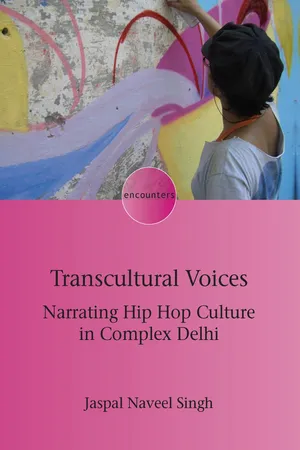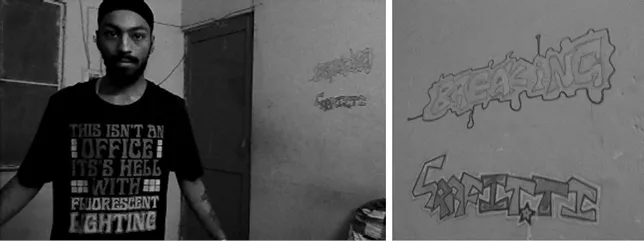![]()
1 Complex Questions: Normalising Voice in Global Narratives
Globalisation: Complex Blessings
Every day my family and I take our blessings from hip hop, said Prabh Deep, a young breaker, graffiti writer, emcee and beat producer from Delhi, as he pointed at two small graffiti (see Figure 1.1) that he had painted with a felt-tipped pen on the wall of his family’s living room in Tilak Nagar, West Delhi. His family, like many others in this neighbourhood, were forced to flee from the side of the Punjab that is now in Pakistan during the traumatic partition in 1947/1948, which fragmented the former British crown colony into two separate nation states. The partition brought approximately 700,000 refugees to Delhi, predominantly Sikhs and Hindus, who settled in so-called Punjabi colonies in all parts of Delhi, swapping the agricultural lifestyles of their pastoral homelands for urban small-scale commerce and services. At the time of my fieldwork in 2013, Prabh Deep, a third-generation Delhiite, worked night-shifts in a call centre office assisting North American clients with their information technology problems; a job that he later quit in order to start a successful career as an emcee.
Figure 1.1 Prabh Deep, ‘Breaking’ and ‘Grafitti’ (Photos by author, Delhi, 2013)
I was instantly fascinated with the two small graffiti that depicted the English words ‘Breaking’ and ‘Grafitti’, referring to two of the hip hop elements that Prabh Deep had been practicing for several years (for working definitions of hip hop and the five elements, see the Glossary of Terms). For me, the interested ethnographer from the West who was searching for hip hop practices in India, these graffiti were textual manifestations – semiotic surfaces as I call them in this book – of the complexities of globalisation.
I asked Prabh Deep for permission to take a picture with my mobile phone camera. He said of course and then pointed me to the opposite wall where he and other family members had painted, also with felt-tipped pens, a depiction of the Hindu god Ganesh, a swastika (a symbol of luck in South Asia) and a motto in Hindi in Devanagari script, to bless the house with fortune. Next to Ganesh was a gold-framed portrayal of Guru Gobind Singh, the tenth guru of Sikhism, flanked by a quote in Punjabi from the holy book of the Sikhs, the Guru Granth Sahib, written in Gurmukhi script. As photographs are often not allowed in temples and gurdwaras in India, I refrained from taking pictures of these sacred icons. Prabh Deep told me that his family and he would touch these icons and scripts on the wall, including his own post-modern additions to the ensemble, and say quick prayers to ‘take blessings’, meaning that they ask for divine protection and fortune, a practice that I frequently observed in Indian houses. For many families in India, Sikhism and Hinduism, as well as Christianity, Islam and Jainism are not incommensurable and it seems that syncretic worshipping and extensive cross-borrowing of religious practices are quite common in Delhi and in India at large (for a critical view on the use of the term ‘syncretism’ for religious practices in India, see Sahay, 2016).
How can we account for hip hop entering the pantheon of Prabh Deep’s family? Are we dealing with a genuine cultural appropriation of hip hop into Indian religiosity, or is this just an insignificant side effect of globalisation? What is the relationship between ‘sacred’ traditions like religious icons and ‘rebellious’ youth cultures like graffiti? Is this an example of bricolage (Hebdige, 1979), cut ’n’ mix (Hebdige, 1987), third space of enunciation (Bhabha, 2004) and transcultural flow (Pennycook, 2007a)? What is the role of English in indexing hip hop in these graffiti? Do these graffiti contest or reproduce English as a colonial language, a lingua franca and a symbol of modernity and middle-class aspiration in urban India? As a linguistic ethnographer, these and similar questions are of great interest to me. They probe some of the discourses at play in what I refer to as ‘transculturation’ in this book. They acknowledge that we are dealing with complexity when we want to account for language in globalisation. However, these are also types of questions that are somewhat imposed from outside. They have been discussed under the rubrics of ‘globalisation’ and ‘multiculturalism’ in (Western) academia for decades at least. Were they also of relevance to the hip hop practitioners I met in the field? Did they think of the appropriation of hip hop in India as something complex, exceptional, noteworthy or even researchable? I will return to this issue in a moment, when I introduce the research question for this study.
Normalising Voice in Narrative
For now, allow me to add another observation, which has to do with the process of normalisation that I try to understand throughout this book. When Prabh Deep showed me the graffiti in his living room and narrated their social functions for him and his family, his voice sounded somewhat ‘normal’. Just after my visit to Prabh Deep’s house on that afternoon, I wrote in my field diary (pp. 60–61) that he used falling intonation and slow rhythm when talking to me about the graffiti. At the time, I interpreted his voice quality as creating a sense of ordinariness, which was only made exceptional by my own interest in the graffiti and my request to take pictures. Arguably, therefore, Prabh Deep himself framed the presence of the graffiti in his family’s living room as somewhat ‘normal’, habitual maybe, even though he found them remarkable enough to present them to the visiting ethnographer.
Prabh Deep’s ‘normal’ sounding voice reminds us of a fundamental problem with ethnographic encounters: what is normal and what is spectacular is not immediately clear and needs to be negotiated between researched and researcher. In their recent book on translinguistics, Lee and Dovchin (2020) ask a similar question:
how can something such as a given linguistic practice or phenomenon be constructed by the researcher as ‘innovative’ (frequently as a euphemism for peculiar, exotic, eccentric, unconventional, or strange) but understood simultaneously by the research subject as everyday, quotidian, basic, mundane, unremarkable, banal, and, quite simply, ordinary? (Lee & Dovchin, 2020: 3, original italics)
Their answer to their question is that, rather than trying to figure out which one is the ‘correct’ interpretation, the simultaneity of both perspectives should be put front and centre in our studies: ‘the analytic potential of translinguistics can be enhanced by accounting for the simultaneities of innovation […] and ordinariness’ (Lee & Dovchin, 2020: 3). Taking inspiration from this idea, I argue in this book that such simultaneities between innovation and ordinariness (as well as other dialectic dynamics) are narratively deployed by Delhi hip hop heads to orchestrate many voices and normalise their ‘own’ voice in relation to this heteroglossia. I use the term transcultural voices as a heuristic to understand such processes of simultaneity, in-between-ness and transformation in narrative normalisations of voice. The trans- prefix gives me some queer wiggle room for making a range of subversive moves in my analysis and my writing. This is so because transcultural voices engage – rather than erase – the complexities of languaging in globalisation, even if they partially normalise complexity. On the pages that follow, I try to understand how hip hop heads in Delhi construct such transcultural voices in narratives to normalise complexity and complexify normality. I also pay critical attention to the ways in which I, as the researcher, fieldworker or analyst, normalise and complexify their, and indeed my, voices and narratives. My complex approach might make the book difficult to read because I am not always able to give clear answers to what is going on exactly; rather, my analytical focus is precisely on the tensions, the simultaneities, that arise from the complex narrative normalisation of voice.
Foucault (1995, 2007) understands normalisations as social, scientific, political, legal and discursive processes by which institutions gain legitimacy and power. Patriarchy or the prison, for example, have been normalised in most societies today in the sense that these institutions of soft and/or hard power find their legitimacy in a populations’ consent and adherence to social norms, which these institutions themselves constructed with the help of modern European science. Yet, it is not only the case that large institutions, such as the nation-state or organised religion, engage in such normalisations – we all do. In our everyday encounters, in the stories we tell each other and also in our academic writing, we usually take certain truths to be true, i.e. certain ideas have become normalised, ordinary, not even worth mentioning. We do so for several reasons, to emulate others and build and maintain social relationships, for example, or simply because we don’t know all the details of what we are talking about.
My participants’ ‘normal’ voice often appeared when they told me stories, or narratives, and especially in the final parts of narratives, when they resolved the tension they created and put forward their ‘own’ voices (see also Singh, 2020b). Narratives have traditionally been understood as consisting of at least two or three parts: a beginning, a middle and an end (as in Aristotle’s classic definition) or an orientation, complicating action and resolution (Labov & Waletzky, 1967). While I work with this structural approach to narrative, I understand narratives as a social practice (De Fina & Georgakopoulou, 2008). Storytelling plays an important role for all of us in maintaining interpersonal relationships, understanding and grappling with our pasts and futures and making tacit knowledge explicit and experiential. Chapter 2 provides a more detailed discussion of narrative practices.
At this point, readers might ask if this book is ‘just’ about stories and not about ‘actual’ hip hop action. Yes and no. While many of the ‘linguistic data extracts’ you will see indeed come from oral narratives that I recorded in interactional interviews with participants, my analysis is deeply informed by my embodied participation in a range of hip hop practices, such as producing rap music and videos with participants, as also further detailed in Chapter 3. The relationships I built with my participants in these ethnographic encounters shaped the stories the participants would tell me, a very few of which I selected to discuss in this book. The narratives you will hear are thus not to be read as some decontextualised stories from ‘out there’, they are not authoritative narratives (Kroskrity, 2009) or cultural myths that exist in some non-ethnographic reality, but rather they are documents of my participant observation. They are co-constructed by the researcher, performed for the researcher even, and they found their ways onto audiotape and on these pages only because of the research taking place. Many interviews were outcomes of weeks and months of hanging out with participants, establishing rapport, bonding through hip hop and collaborating over artistic projects. Thus, these stories (and their interpretation in this book) are infused with the ethnographic relation...

